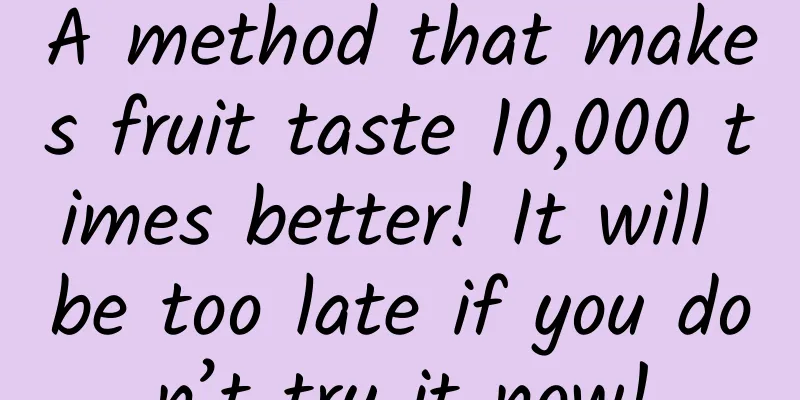A method that makes fruit taste 10,000 times better! It will be too late if you don’t try it now!

|
As summer is about to begin, many summer fruits are about to say goodbye to us. How can we keep them longer? Seize the last chance and make some frozen fruits! Freezing the sweet summer fruits seems to seal up the comfort in the summer heat. What’s so good about frozen fruit? 1. Greatly extend the shelf life of fruits Generally, the sweeter the fruit, the higher its sugar content (some fruits are sweet but not high in sugar, such as watermelon and peach), and the more susceptible they are to bacterial invasion and spoilage. However, the low temperature of freezing can greatly delay or even stop the spoilage process of fruits, allowing us to taste the original sweetness of summer fruits for a long time. Copyright images in the gallery. Reprinting and using them may lead to copyright disputes. 2. Better preserve the nutrients of food Studies have found that quick-frozen fruits lose nutrients very slowly. Even after being stored for several months, the nutrients they contain are not much different from those of fresh fruits [1]. Temperature and storage time have a great impact on the various nutrients in fruits, especially the content of vitamin C and B group. The higher the temperature and the longer the storage time, the more serious the loss of vitamins. With the continuous development of food industry technology, low-temperature quick freezing can stop the metabolism and respiration of cells inside fruits in a very short time, thereby curbing the consumption and loss of nutrients [2-3]. Even if the fruit is frozen hard, its nutrition is not compromised . 3. After freezing, it is sweeter and has a new taste Although freezing affects the flavor of fresh fruits, the sweetness remains the same or even higher. Since the fructose in fruits increases its sweetness at low temperatures, many fruits, such as watermelon, lychee, grapes, cantaloupe, mango, etc., are sweeter after being frozen than at room temperature . In terms of taste and texture, although frozen fruits have lost the crispness or softness of fresh fruits, they have a special taste similar to ice cream, popsicles, and smoothies. They are lower in fat and sugar, healthier, and more natural than most ice creams sold on the market, and are just as enjoyable to eat. In short, frozen fruit is generally not inferior to fresh fruit in terms of nutritional value or taste . As a method that can greatly extend the shelf life of fruit, I vote for it with both hands. Copyright images in the gallery. Reprinting and using them may lead to copyright disputes. Delicious frozen fruit, choosing the right type is important If you want to make delicious and nutritious frozen fruits, choosing the right fruit is an important first step. Because not every kind of fruit is suitable for freezing, and the taste of different fruits after freezing varies greatly. 1. For denser ice cream, choose more "dry" fruits If you usually like ice cream with milk, cream, cheese and other ingredients as the main ingredients and a smooth and dense texture, then it is recommended that you choose fruits with relatively low water content and high "dry goods" content, such as bananas, durian, mango, papaya, and jackfruit . Especially bananas and durian, the taste after freezing is not inferior to those expensive "ice cream assassins". After freezing, the flesh of these fruits becomes denser and sweeter, without large ice chips or melting into water when you eat them. After taking them out of the freezer and letting them warm up a little, you can slowly scoop them out with a spoon and eat them. They are extremely delicious. 2. For a sweet smoothie, choose fruits that are sweet and have more water content Friends who like to eat smoothies can freeze more fruits with high sweetness and high water content. For example, pineapple, cantaloupe, watermelon, kiwi, pear, etc. Although these fruits are a bit hard after being frozen, it is a bit difficult for teeth to chew them. But as long as you use a food processor or a wall breaker to blend them slightly, you can get a fruit smoothie with sweet juice bursting in your mouth. It tastes good whether you eat it directly or with fresh fruits, milk, or yogurt. Copyright images in the gallery. Reprinting and using them may lead to copyright disputes. 3. Drink fruit cold or chew it, choose small, sweet and sour fruits If you have good teeth and like to chew frozen fruits directly, or like to make homemade fruit ice drinks, then choose small, sweet and sour fruits , such as grapes, raisins, cherries, strawberries, bayberries, lychees, blueberries, raspberries, etc. These fruits are rich in water and have a sweet and sour taste. They taste like smoothies when chewed directly, and they can slowly release their sweetness when made into ice drinks. Frozen fruit eating methods The first issue to be addressed is whether the frozen fruit needs to be thawed . In fact, no matter what kind of frozen fruit, as long as your teeth and stomach can tolerate it, you can eat it directly without thawing it (just like eating ice cream), or you can leave it for a few minutes and eat it when the surface is slightly thawed. If you feel that the frozen fruit is too cold, frozen too hard, or your stomach cannot tolerate low temperatures, you can put it in the refrigerator to thaw it slightly before eating. Now let's answer the question about the various ways to eat frozen fruits. In addition to eating them directly, making smoothies, or using them as ice cubes to make iced drinks, frozen fruits can also be eaten with milk or yogurt . For example, add yogurt to fruits such as raspberries and lychees, freeze them together, and you have yogurt fruit ice cream. For example, you can mix frozen watermelon, cantaloupe, pear and other fruits with yogurt and milk to make a milkshake to make yogurt/milk fruit smoothie. For a simpler way, you can directly mix frozen fruits with yogurt, which tastes good. Copyright images in the gallery. Reprinting and using them may lead to copyright disputes. If you want to give your children something different, you can also cover larger pieces of frozen fruit such as frozen durian and frozen mango that have just been taken out of the freezer with yogurt. When the yogurt solidifies slightly at low temperature, sprinkle a layer of low-sugar cereal/oatmeal rings on it to bring a richer taste experience . A Guide to Avoiding Pitfalls in Frozen Fruits In addition to choosing different types of fruits, the following factors are also critical to the success rate of freezing fruits. 1. Quality of fresh fruit The more intact the peel of fresh fruit is, the less likely it is to deteriorate in quality during the washing and freezing process. In addition, the more mature the fresh fruit is, the sweeter it is and the stronger its aroma is. Choosing such fruit for freezing can preserve the fruit in its best condition and produce the sweetest and most fragrant "fruit ice cream" or "fruit smoothie". 2. Handling and Packaging before Freezing Be sure to wash the selected fruits thoroughly before freezing; those fruits with skins should be peeled so that they can be eaten directly after freezing without thawing; large fruits such as watermelon and cantaloupe should be cut into pieces or slices for easy eating or processing into smoothies or iced drinks . When freezing, in order to achieve the purpose of "quick freezing", you can use a clean cutting board or tray (metal cutting board and tray can speed up freezing efficiency) to lay the processed fruits out flat at intervals, and then store them in clean containers after freezing. This can not only freeze quickly, reduce damage to nutrition and taste, but also prevent the flesh from being squeezed together and frozen into a large block. 3. Pay attention to the freezing time and temperature If you want to freeze quickly, the temperature must be low. Generally, the temperature for household quick freezing should be set below -18 degrees Celsius, preferably around -25 degrees Celsius. Quick freezing the fruit for more than 3 hours can generally complete the quick freezing process. It should be noted that during the quick freezing process, try not to open the refrigerator door to avoid temperature changes and affect the quick freezing effect . Autumn is about to arrive, and summer’s exclusive fruits will gradually be off the shelves. Let us say goodbye to summer with this last wave of delicious frozen fruits! Finally, a table allows everyone to more intuitively understand which fruits are more suitable for freezing~ References [1]Rickman JC, BarrettDM,Bruhn CM.Nutritional comparison of fresh, frozen and canned fruits andvegetables.Part1.Vitamins C and B and phenolic compounds[J].Journal of the enceof Food & Agriculture,2010,87(6):930-944. [2] Wang Menglei. Effects of cooking and storage on the effective nutrition and functional value of fruits and vegetables[D]. Henan University of Technology, 2014. [3] Wang Changwen, Ma Hongbo, Yang Jingjing. Effects of different storage conditions on the content of vitamin B1, B2 and vitamin C in seabuckthorn fruit[J]. Journal of Jilin Medical College Journal of Journal of Chinese Academy of Sciences, 2013, 34(01): 22-23. Author: Wang Lu, registered dietitian in China Review|Ruan Guangfeng, Deputy Director of Kexin Food and Health Information Exchange Center |
<<: The "Giant Panda" in the farmland: We finally know how old it is!
Recommend
How did Yuan blue and white porcelain, the ancestor of blue and white porcelain, appear and become popular in the world?
The Yuan blue and white double-handled small jar ...
Will the “little potatoes” really not get dirty if they don’t scrub their bodies for years?
This winter, tourism in Harbin is booming. Accord...
Why is the golden pupa golden?
Wow, golden legend! What do you think of when you...
How should brands advertise on Xiaohongshu?
Today, no one will deny the importance of online ...
Tips for optimizing information flow advertising promotion!
The placement of information flow advertising is ...
Have you ever seen a "mini duck" that looks like a ball of cotton?
Dongting Lake is the best water in the world, and...
Will scratching the inner pot of a rice cooker be harmful to human health?
I wonder if you have ever paid attention to the r...
How to provide early warning for user churn?
Recalling lost users is ineffective? The attritio...
This is how advertisements will look good, here are the secrets to placing advertisements in the dating industry!
The threshold for entering the current marriage a...
Cocos Store content submission is officially open to create a full-type resource sharing platform
At the Cocos Developer Conference (Spring) on A...
What exactly does community operation do?
Community operation has always been a difficult p...
How does the gaming business, which accounts for 83.4% of Bilibili’s revenue, operate?
Recently, bilibili released its IPO prospectus, a...
How do I attract targeted customers through Zhihu?
Hello everyone! The following tutorial can help y...
A set of offline activity diversion fission solutions
There are many ways to increase private domain tr...
Google complies with EU regulations: provides Android users with 12 optional search engines
According to reports, Google announced today that...









